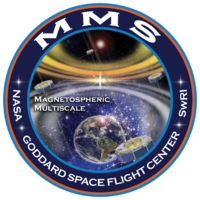
Back بعثة متعددة المهام للغلاف المغناطيسي Arabic Magnetospheric Multiscale Mission German Magnetospheric Multiscale Mission French Magnetospheric Multiscale Mission ID Magnetospheric Multiscale Mission Portuguese Magnetospheric Multiscale Mission Russian Magnetospheric Multiscale Mission Ukrainian
 Artist depiction of MMS spacecraft | |
| Names | MMS |
|---|---|
| Mission type | Magnetosphere research |
| Operator | NASA |
| COSPAR ID | 2015-011A, 2015-011B, 2015-011C, 2015-011D |
| SATCAT no. | 40482, 40483, 40484, 40485 |
| Website | MMS [1] |
| Mission duration | Planned: 2 years Elapsed: 9 years, 4 months, 13 days |
| Spacecraft properties | |
| Manufacturer | Goddard Space Flight Center |
| Launch mass | 1,360 kg (3,000 lb) |
| Dimensions | Stowed: 3.5 × 1.2 m (11.5 × 3.9 ft) Deployed: 112 × 29 m (367 × 95 ft) |
| Power | 318 watts |
| Start of mission | |
| Launch date | 13 March 2015, 02:44 UTC |
| Rocket | Atlas V 421 (AV-053) |
| Launch site | Cape Canaveral, SLC-41 |
| Contractor | United Launch Alliance |
| Entered service | September 2015 |
| End of mission | |
| Last contact | 2040 (planned) |
| Orbital parameters | |
| Reference system | Geocentric orbit |
| Regime | Highly elliptical orbit |
| Perigee altitude | 2,550 km (1,580 mi) |
| Apogee altitude | Day phase: 70,080 km (43,550 mi) Night phase: 152,900 km (95,000 mi) |
| Inclination | 28.0° |

| |
The Magnetospheric Multiscale (MMS) Mission is a NASA robotic space mission to study the Earth's magnetosphere, using four identical spacecraft flying in a tetrahedral formation.[1] The spacecraft were launched on 13 March 2015 at 02:44 UTC.[2] The mission is designed to gather information about the microphysics of magnetic reconnection, energetic particle acceleration, and turbulence — processes that occur in many astrophysical plasmas.[3] As of March 2020, the MMS spacecraft has enough fuel to remain operational until 2040.[4]
- ^ "MMS Spacecraft & Instruments". NASA. 3 August 2017. Retrieved 12 March 2020.
 This article incorporates text from this source, which is in the public domain.
This article incorporates text from this source, which is in the public domain.
- ^ "MMS Launch". NASA. 2 April 2015. Retrieved 12 March 2020.
 This article incorporates text from this source, which is in the public domain.
This article incorporates text from this source, which is in the public domain.
- ^ Lewis, W. S. "MMS-SMART: Quick Facts". Southwest Research Institute. Archived from the original on 9 September 2014. Retrieved 5 August 2009.
- ^ Johnson-Groh, Mara (12 March 2020). "NASA's MMS Marks its 5th Year Breaking Records in Space". NASA. Retrieved 12 March 2020.
 This article incorporates text from this source, which is in the public domain.
This article incorporates text from this source, which is in the public domain.
© MMXXIII Rich X Search. We shall prevail. All rights reserved. Rich X Search